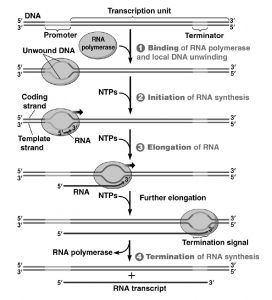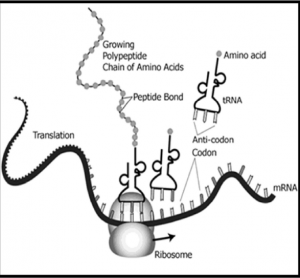Process of gene expression
- Transcription
- Initiation
- Elongation
- Termination
- Processing
- Translation
- Initiation
- Elongation
- Termination
- Post-translation processing of the protein
Some genes are responsible for the production of other forms of RNA that play a role in translation, including transfer RNA (t-RNA) and ribosomal RNA (r- RNA).
Exons: Exons code for amino acids and communally conclude the amino acid sequence of the protein product.

Introns: Introns are portions of the gene that do not code for amino acids, and are removed (spliced) from the mRNA molecule before translation
The process of gene expression involves two main stages:
- Transcription: Transcription is the process of RNA synthesis, inhibited by the communication of promoters and enhancers. Several different types of RNA are produced, including messenger RNA(mRNA), which specify the sequence of amino acids in the protein product, and transfer RNA (tRNA) and ribosomal RNA (rRNA), which play a role in the translation process. Transcription involves four steps:
- Initiation: The DNA molecule unwinds and separates to form a small open complex. RNA polymerase binds to the promoter of the template strand. The synthesis of RNA proceeds in a 5′ to 3′ direction, so the template strand must be 3′ to 5′.
- Elongation: RNA polymerase moves along the template strand, synthesizing an mRNA molecule. In prokaryotes RNA polymerase is a holoenzyme consisting of a number of subunits, including a sigma factor (transcription factor) that recognizes the promoter. In eukaryotes there are three RNA polymerases: I, II and III. The process includes a proofreading mechanism.
- Termination: In prokaryotes there are two ways in which transcription is terminated. In Rho-dependent termination, a protein factor called “Rho” is responsible for disrupting the complex involving the template strand, RNA polymerase and RNA molecule. In Rho-independent termination, a loop forms at the end of the RNA molecule, causing it to detach itself. Termination in eukaryotes is more complicated, involving the addition of additional adenine nucleotides at the 3′ of the RNA transcript (a process referred to as polyadenylation).
- Processing: After transcription the RNA molecule is processed in a number of ways: introns are removed and the exons are spliced together to form a mature mRNA molecule consisting of a single protein-coding sequence. RNA synthesis involves the normal base pairing rules, but the base thymine is replaced with the base uracil.

- Translation: In translation the mature mRNA molecule is used as a template to assemble a series of amino acids to produce a polypeptide with a specific amino acid sequence. The complex in the cytoplasm at which this occurs is called ribosome. Ribosome is a mixture of ribosomal proteins and ribosomal RNA (rRNA), and consists of a large subunit and a small subunit. Translation involves four steps:
- Initiation: The small subunit of the ribosome binds at the 5′ end of the mRNA molecule and moves in a 3′ direction until it meets a start codon (AUG). It then forms a complex with the large unit of the ribosome complex and an initiation tRNA molecule.
- Elongation: Subsequent codons on the mRNA molecule determine which tRNA molecule linked to an amino acid binds to the mRNA. An enzyme peptidyl transferase links the amino acids together using peptide bonds. The process continues, producing a chain of amino acids as the ribosome moves along the mRNA molecule.
- Termination: Translation in terminated when the ribosomal complex reached one or more stop codons (UAA, UAG, UGA). The ribosomal complex in eukaryotes is larger and more complicated than in prokaryotes. In addition, the processes of transcription and translation are divided in eukaryotes between the nucleus (transcription) and the cytoplasm (translation), which provides more opportunities for the regulation of gene expression.
